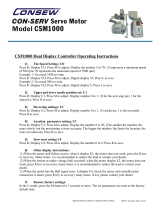
SJ100 Inverter
Appendix A
A–3
DC Braking
The inverter DC braking feature stops the AC commutation to the
motor, and sends a DC current through the motor windings in order
to stop the motor. Also called “DC injection braking,” it has little
effect at high speed, and is used as the motor is nearing a stop.
Dead Band
In a control system, the range of input change for which there is no
perceptible change in the output. In PID loops, the error term may
have a dead band associated with it. Dead band may or may not be
desirable; it depends on the needs of the application.
Digital Operator Panel
For Hitachi inverters, “digital operator panel” (DOP) refers first to
the operator keypad on the front panel of the inverter. It also
includes hand-held remote keypads, which connect to the inverter
via a cable. Finally, the DOP Plus is a PC-based software simula-
tion of the keypad devices.
Diode
A semiconductor device which has a voltage-current characteristic
that allows current to flow only in one direction, with negligible
leakage current in the reverse direction. See also rectifier.
Duty Cycle
1. The percent of time a square wave of fixed frequency is on (high)
versus off (low). 2. The ratio of operating time of a motor, braking
resistor, etc. to its resting time. This parameter usually is specified
in association with the allowable thermal rise for the device.
Dynamic Braking
The inverter dynamic braking feature shunts the motor-generated
EMF energy into a special braking resistor. The added dissipation
(braking torque) is effective at higher speeds, having almost no
effect as the motor nears a stop.
Error
In process control, the error is the difference between the desired
value or setpoint (SP) and the actual value of a the process variable
(PV). See also process variable and PID Loop.
EMI
Electromagnetic Interference - In motor/drive systems, the switch-
ing of high currents and voltages creates the possibility of generat-
ing radiated electrical noise that may interfere with the operation of
nearby sensitive electrical instruments or devices. Certain aspects of
an installation, such as long motor lead wire lengths, tend to
increase the chance of EMI. Hitachi provides accessory filter
components you can install to decrease the level of EMI.
Four-quadrant
operation
Referring to a graph of torque versus direction, a four-quadrant
drive can turn the motor either forward or reverse, as well as decel-
erate in either direction (see also reverse torque). A load that has a
relatively high inertia and must move in both directions and change
directions rapidly requires four-quadrant capability from its drive.
Free-run Stop
A method of stopping a motor, caused when the inverter simply
turns off its motor output connections. This may allow the motor
and load to coast to a stop, or a mechanical brake may intervene and
shorten the deceleration time.






















